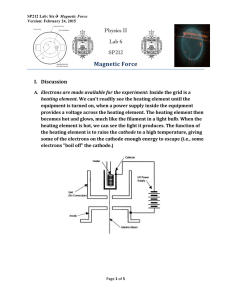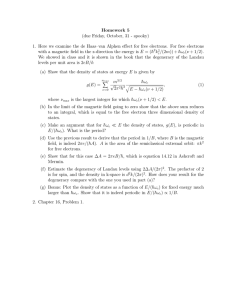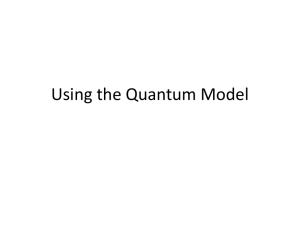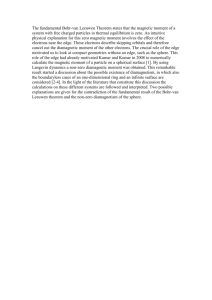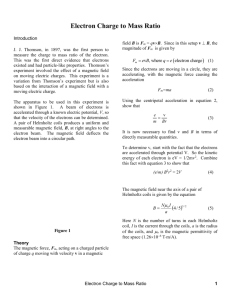Magnetic Force PHYSICS II
advertisement
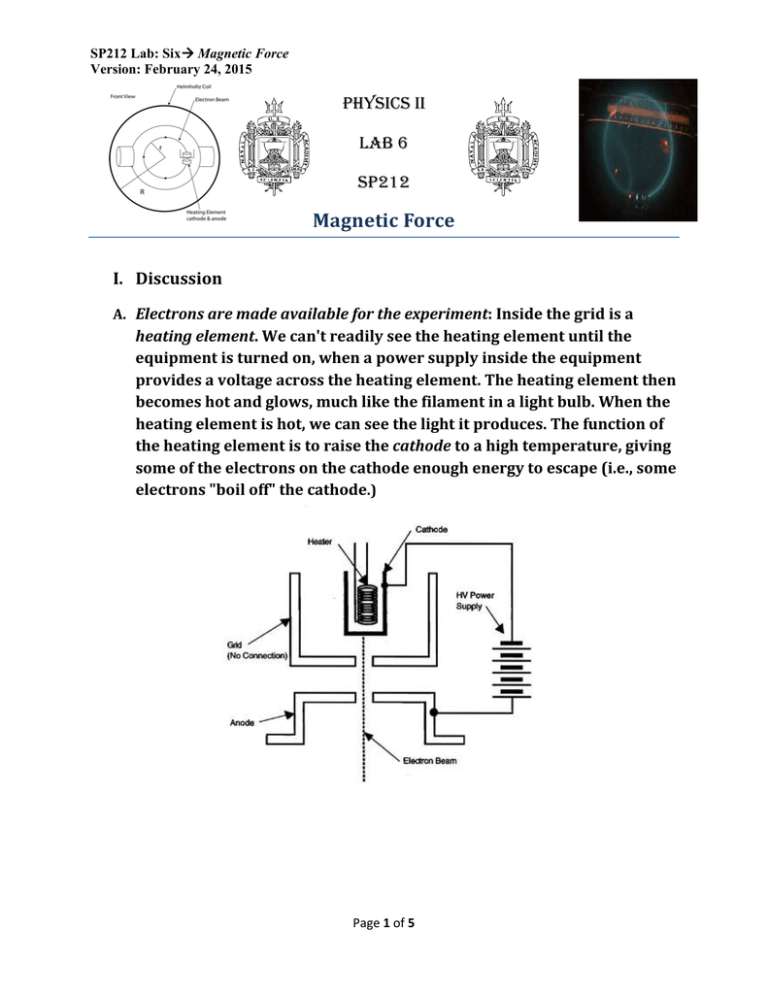
SP212 Lab: Six Magnetic Force Version: February 24, 2015 PHYSICS II LAB 6 SP212 MagneticForce I. Discussion A. Electronsaremadeavailablefortheexperiment:Insidethegridisa heatingelement.Wecan'treadilyseetheheatingelementuntilthe equipmentisturnedon,whenapowersupplyinsidetheequipment providesavoltageacrosstheheatingelement.Theheatingelementthen becomeshotandglows,muchlikethefilamentinalightbulb.Whenthe heatingelementishot,wecanseethelightitproduces.Thefunctionof theheatingelementistoraisethecathodetoahightemperature,giving someoftheelectronsonthecathodeenoughenergytoescape(i.e.,some electrons"boiloff"thecathode.) Page 1 of 5 SP212 Lab: Six Magnetic Force Version: February 24, 2015 B. The electrons are then accelerated between the cathode and the anode: A large potential difference (voltage, Vaccel) is established between the cathode and the anode. Most of the "boiled off" electrons collide with the grid. However, a few electrons are going in the right direction and are accelerated through a hole in the grid toward the anode. A fortunate few of these electrons actually pass through another hole in the anode, forming the electron beam that we will study. Those electrons that escape to form our electron beam will have a velocity that we can calculate. In summary, we have electrons initially moving downward in the glass tube with a speed we can calculate! 1 2 2(e)(Vaccel ) mv qVaccel v 2 m C. The electron beam is made observable: If the tube were at atmospheric pressure, the electrons would not travel far because of collisions with the air molecules. For this reason, most of the air has been removed. However, the path of the electrons is still not observable even with the air removed. To make the "trail" of electrons observable, low-pressure helium gas exists inside the tube. The helium enables us to see the path of the electrons because a helium atom fluoresces (emits bluish light) when an electron collides with it. D. The electron beam is bent into a circle: A magnetic field causes the electrons to travel in a circle once they exit the metal cylinder. This magnetic field is produced by an electric current in a large set of coils outside the tube. There are two sets of circular coils of radius R that are separated from each other by the distance R. Coils in this configuration are known as Helmholtz coils. The special characteristic of Helmholtz coils is that they produce a relatively uniform magnetic field near the center of the configuration. Our electron beam will be located near the center of the coil configuration in the uniform magnetic field. r mv eB Note: The numbers on the bar indicate the beam diameter in centimeters (not the radius!). Page 2 of 5 SP212 Lab: Six Magnetic Force Version: February 24, 2015 II. TurninyourPre‐lab/homeworkproblemifassigned. III.Procedure A. PreliminaryMeasurements 1. Valuesofthefundamentalphysicalconstantse,me,andµ0have beenenteredforyouintothespreadsheettemplateforthis exercise.NotethatI’veenteredtheirvaluesaccuratelyto9 significantdigits.Therearesomeuncertainties,buttheyare sosmallthattheywillnotaffectyouruncertaintycalculations verymuch,andwemaytreatthesequantitiesasexactforthe purposesofthisexercise. 2. Youwillneedtomeasuretheaveragediameterofyour Helmholtz(Hh)coilsandentertheresultinyourspreadsheet. Themanufacturer’sinstructionmanualstatesthateachcoilis madewith132turnsofwire.Themagneticfieldnearthe centeroftheHhcoilsisproportionaltothecurrentflowing throughthem;theproportionalityconstantis [8*N*µ0]/[R*sqrt(125)]. B [ 8N 0 ]*i B [constant]*i 125 R We will learn more about this in CH‐29, if you haven’t already. Note: R is the radius (and separation) of the Helmholtz coils. i. Calculatethisproportionalityconstantvalueandenterit intheappropriatecellinyourspreadsheet,alongwithits uncertainty. ii. Discussion:Inaparagraphconsistingofafewsentences, describehowyoumeasuredtheaveragevalueofthe diameterofyourHhcoils. Please follow the instructions carefully. The equipment that we are about to use is very expensive. Page 3 of 5 SP212 Lab: Six Magnetic Force Version: February 24, 2015 B. FirstExperimentalRun:Vaccel=200Volts. 1. Turn on the power switch to the equipment. The unit will do a 30 second self-test and will energize the filament. The displays will stabilize and read "000";iftheydon’tbothsteadyoutatzeroinlessthanaminute,let yourinstructorknow. DO NOT TAKE DATA FOR AT LEAST 5 MINUTES. 2. Aftertheybothsteadyoutatzero,turntheacceleratingvoltageupto200 V,andtheHhcurrentto1.6Amperes.Youshouldseeaneerieblue‐green electronbeambentintoafullcircle;thisshouldgetbrighterforabout5 minutes.Afteryourinstrumentisfullywarmedup,youmaybegintaking data. 3. Withtheacceleratingpotentialsetat200V(theuncertaintyisoneVolt), gentlychangetheHhcoilcurrentuntilthediameteroftheelectron trajectoryis11.0cm,or0.11m.Recordthediameterandthecurrent requiredtobendthebeamtothisdiameter.Similarly,recordthecurrents requiredtobendthebeamintodiametersof10,9,8,7,6,and5cm. 4. Youmaywishtocranktheacceleratingvoltageup,to300Vandtakethe dataforPartCatthistime,beforereturningtothecalculationsdescribed inthenextparagraph. 5. Calculations: i. Fromtheorbitaldiameter,calculatetheorbitalradius. ii. FromtheHhcoilcurrent,calculatethemagneticfieldusingthe proportionalityconstantyoucalculatedinPartA.(Don’tforgetto useabsoluteaddressing!) iii. Onceyou’vecalculatedB,itiseasytocalculatethemagneticforce. iv. Next,calculatethecentripetalforcerequiredtobendthebeaminto theobservedradius,mv2/r:Youalreadyhavetheelectrons’KE, whichismv2/2;multiplythatby2anddividebyr,andyou’vegot her. v. Thencalculatethe%differencebetweenyourmagneticand requiredforces.Inthelastcolumn,calculatethevalueof 2*Vaccel/r2B2;asyousawfromthehomeworkproblem,thisshould beequaltothecharge‐to‐massratiofortheelectron,calculatedin PartA. Page 4 of 5 SP212 Lab: Six Magnetic Force Version: February 24, 2015 C. SecondExperimentalRun:Vaccel=300Volts 1. RepeatPartIII.BwithanacceleratingpotentialofVaccel=300V. 2. Discussion:DiscussionforpartsBandC:Doyourresultsshowthatthe magneticforceactsasacentripetalforceandbendstheelectrons’ trajectoriesintocircles?Doesyourexperimentalvaluefortheratioe/m agreewiththevaluecalculatedfromthewell‐knownphysicalconstants? D. LabReporttohandin: 1. PreliminaryDataspreadsheet,withdiscussionsfrompartA,andfrom partsBandC. 2. Datasheetforfirstrun,withVaccel=200V. 3. Datasheetforsecondrun,withVaccel=300V. Don’tforgetuncertainties,units,annotationsanddiscussions. IV. Clean‐Up A. GoldenRule:“Dountoothersasyoudesirethemtodountoyou.” ThisappliesasmuchhereinthelabasitdoesintheFleet.AsfutureNavalOfficers, howcanyouexpectyourenlistedsailorstomaintainacleanworkareaifyour stateroom,workareas,messarea,etcisa“pigsty?”Soasofficersitisimperativethat wecleanupafterourselvesnotonlytofollowtheGoldenRule,butalsotoleadby examplefortheenlistedpersonnelunderourcharge. 1. EndofLabCheckout:Beforeleavingthelaboratory,pleasetidyupthe equipmentattheworkstationandquitallrunningsoftware. 2. Thelabstationshouldbeinbetterconditionthanwhenyouarrivedandmore importantly,shouldbeofanappearancethatyouwouldbePROUDtoshowto yourlegalguardiansduringa“ParentsWeekend.” 3. Haveyourinstructorinspectyourlabstationandreceivetheirpermissionto leavetheLabRoom. 4. YouSHALLfollowthisprocedureduringeverylabforSP212! Many thanks to Dr. Huddle and Dr. Fontanella for their assistance in producing this Laboratory procedure; specific references can be supplied on request. LCDR Timothy Shivok Page 5 of 5
